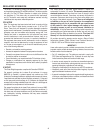
4
Copyright © 2013 Linear LLC 234730 AX2 P1774 X3
REGULATORY INFORMATION
The WT00Z-1 is certifi ed to comply with applicable FCC and IC rules
and regulations governing RF and EMI emissions. This device complies
with part 15 of the FCC Rules. Operation is subject to the following
two conditions: (1) This device may not cause harmful interference,
and (2) This device must accept any interference received, including
interference that may cause undesired operation.
FCC NOTICE
Note: This equipment has been tested and found to comply with the
limits for a Class B digital device, pursuant to part 15 of the FCC
Rules. These limits are designed to provide reasonable protection
against harmful interference in a residential installation. This equipment
generates, uses, and can radiate radio frequency energy and, if not
installed and used in accordance with the instructions may cause
harmful interference to radio communications. However, there is no
guarantee that interference will not occur in a particular installation. If
this equipment does cause harmful interference to radio or television
reception, which can be determined by turning the equipment off and
on, the user is encouraged to try to correct the interference by one or
more of the following measures:
• Reorient or relocate the receiving antenna.
• Increase the separation between the equipment and receiver
• Connect the equipment into an outlet on a circuit different from that
to which the receiver is connected
• Consult the dealer or an experienced radio/TV technician to help.
• Changes or modifications not expressly approved by the party
responsible for compliance could void the user’s authority to operate
the equipment
IC NOTICE
This Class B digital apparatus complies with Canadian ICES-003
Cet appareil numérique de la classe B est conforme à la norme
NMB-003 du Canada. Le présent appareil est conforme aux CNR
d’Industrie Canada applicables aux appareils radio exempts de licence.
L’exploitation est autorisée aux deux conditions suivantes : (1) l’appareil
ne doit pas produire de brouillage, et (2) l’utilisateur de l’appareil doit
accepter tout brouillage radioélectrique subi, même si le brouillage est
susceptible d’en compromettre le fonctionnement.
Cet appareil numérique de la classe B est conforme à la norme NMB-
003 du Canada. Operation is subject to the following two conditions: (1)
this device may not cause interference, and (2) this device must accept
any interference, including interference that may cause undesired
operation of the device.
WARRANTY
This Linear product is warranted against defects in material and
workmanship for twelve (12) months. This warranty extends only to
wholesale customers who buy direct from Linear or through Linear’s
normal distribution channels. Linear does not warrant this product to
consumers. Consumers should inquire from their selling dealer as to
the nature of the dealer’s warranty, if any. There are no obligations
or liabilities on the part of Linear Corporation for consequential
damages arising out of or in connection with use or performance
of this product or other indirect damages with respect to loss
of property, revenue, or profi t, or cost of removal, installation, or
reinstallation. All implied warranties, including implied warranties for
merchantability and implied warranties for fi tness, are valid only until
Warranty Expiration Date as labeled on the product. This Linear LLC
Warranty is in lieu of all other warranties express or implied.
All products returned for warranty service require a Return Product
Authorization Number (RPA#). Contact Linear Technical Services at
1-800-421-1587 for an RPA# and other important details.
IMPORTANT !
Linear radio controls provide a reliable communications link and fi ll an
important need in portable wireless signaling. However, there are some
limitations which must be observed.
• For U.S. installations only: The radios are required to comply with
FCC Rules and Regulations as Part 15 devices. As such, they have
limited transmitter power and therefore limited range.
• A receiver cannot respond to more than one transmitted signal at a
time and may be blocked by radio signals that occur on or near their
operating frequencies, regardless of code settings.
• Changes or modifications to the device may void FCC compliance.
• Infrequently used radio links should be tested regularly to protect
against undetected interference or fault.
• A general knowledge of radio and its vagaries should be gained prior
to acting as a wholesale distributor or dealer, and these facts should
be communicated to the ultimate users.






